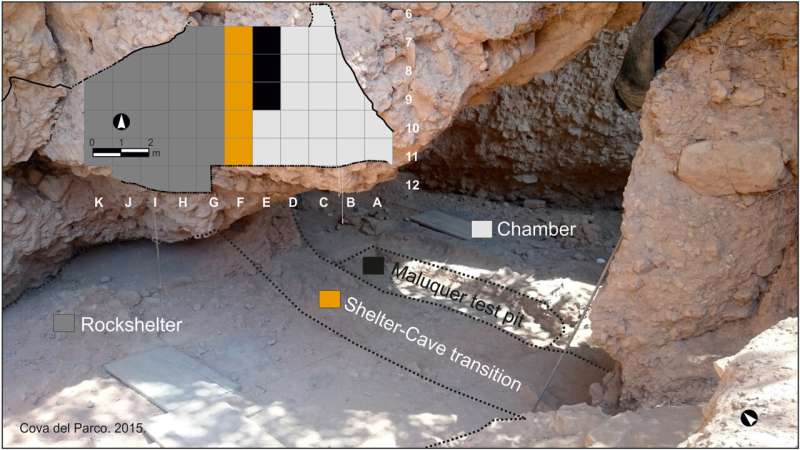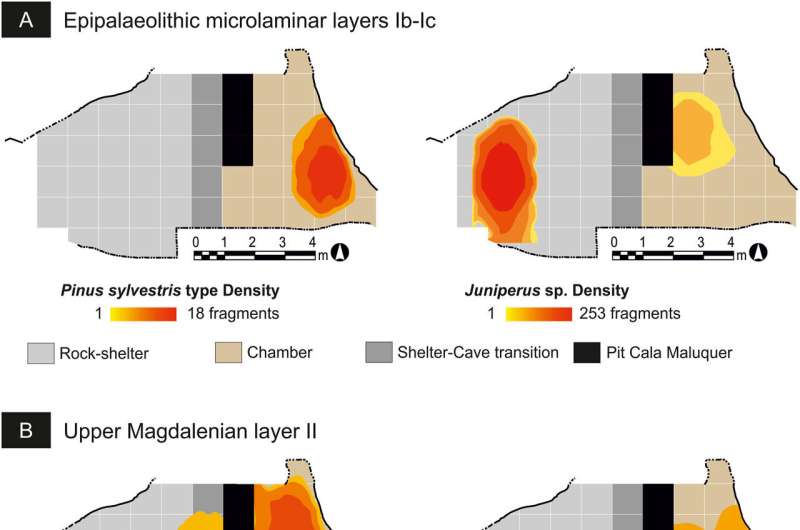September 7, 2023 feature
This article has been reviewed according to Science X's editorial process and policies. Editors have highlighted the following attributes while ensuring the content's credibility:
fact-checked
peer-reviewed publication
trusted source
proofread
Paleolithic hunter-gatherer hearths reveal changing vegetation in response to climate

Human reliance upon the surrounding environmental for natural resources has aided our survival for thousands of years. While the impact of climate change is an ever-present stressor in current communities, it is not solely a modern issue.
New research published in Quaternary Science Reviews has investigated how Paleolithic communities (Magdalenians) living in Cova del Parco (Iberian Pre-Pyrenees, southwest Europe) during the Late Pleistocene (16,400–12,700 years before present) may have been affected by the changing landscape in response to climate. This was a time of deglaciation, with fluctuations in temperature and aridity affecting vegetation.
Bàrbara Mas, a Ph.D. Researcher at the University of Barcelona, and colleagues turned to the wood these communities burnt for cooking, heating and lighting during their seasonal hunter-gatherer activities to unravel this story.
Cova del Parco is an archaeological site defined as a rock-shelter; it is comprised of a single cavity chamber measuring 10.5m long and 4.5m wide. A test pit was cored from the hearth of the chamber, from which charcoal remains were studied (known as anthracology) and radiocarbon dated, indicating the types of trees in the area being felled and tracking changes in forest composition through time.
The research team identified 11 arboreal and shrub taxa from the 1993 charcoal fragments studied under a microscope, with the caveats of wood decay from insect and fungal attack, environmental conditions impacting growth patterns, deformation due to carbonization during combustion, chemical weathering and disturbance by animals/people.
Nevertheless, two forms dominate the charcoal record at Cova del Parco: mountainous pinewood (Pinus sylvestris type) was most abundant in the main cave chamber (comprising over 70% of identified fragments), reflecting its establishment in the area up to 11,700 years before present, while juniper predominated in the rock shelter. However, they found a change to shrubby juniper (Juniperus species) within the cave chamber through time (peaking at >92% of charcoal fragments) as the population adapted their fuel use to the landscape.

Combining the charcoal record with other paleoenvironmental data, the researchers note that pollen indicates a shift from a semi-open landscape to steppe-like conditions, this being unforested grassland.
Despite this, evidence for a sparse pine forest and juniper shrubland throughout this environment is supported here as well as in the sedimentary record, where semi-arid cold conditions favored the expansion of juniper shrub species in particular as it is tolerant to both drought and extreme temperatures.
Animal bones preserved at the site also support these environmental conditions, with the presence of Pyrenean goat, red deer, aurochs and rabbits. This environmental change concurs with analyses of other sites in Iberia and southeast France and is proposed to have happened gradually, over approximately 4000 years.
Such vegetation change would have led to the local community altering their fuel usage habits to capitalize on the available combustible material for heating in the cold environment as well as cooking their prized hunts. Evidence of deadwood pine reserves were found near the edges of the chamber, stored for later use due to its utility for long-lasting combustion and high-luminosity resins. Meanwhile juniper wood is known for its disinfectant properties when burnt and for smoking food.
Today, the area comprises ballota oak woodland at altitudes up to 1200m above sea level, with some deciduous acers and mountainous pines in the canopy and lower-lying evergreen juniper and deciduous shrubs (such as honeysuckle and blackthorn) below. Given the study site is situated in an area prone to climate fluctuations, with warm, dry summers and cold winters down to -4°C, and is highly susceptible to year-round aridity, the consequences of climate change shifting forest populations in the future is a key focus for continued research, no matter the timescale.
More information: Bàrbara Mas et al, Late Paleolithic hunter-gatherers' resilience in the face of the transformation of the vegetation landscape and climate change in the Pre-Pyrenees, Quaternary Science Reviews (2023). DOI: 10.1016/j.quascirev.2023.108276
Journal information: Quaternary Science Reviews
© 2023 Science X Network




















